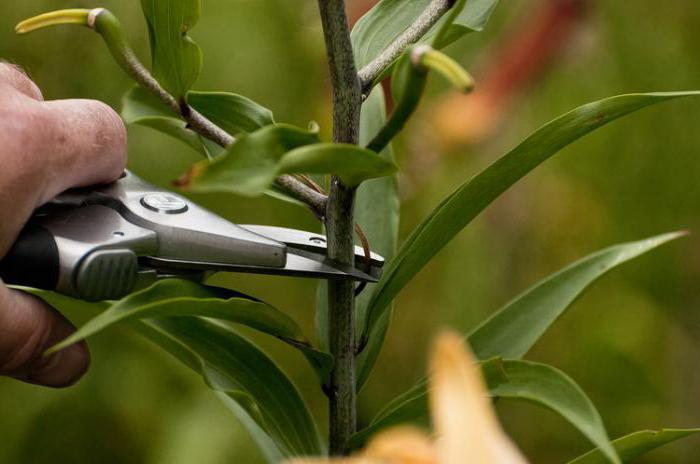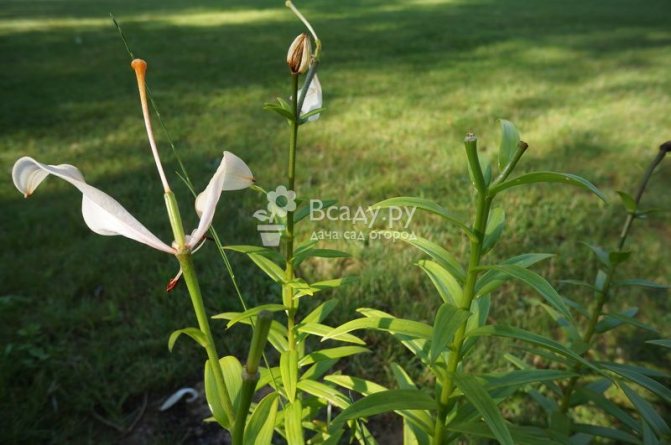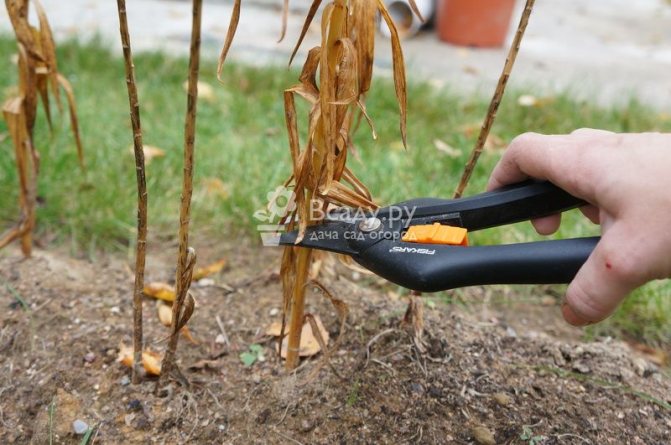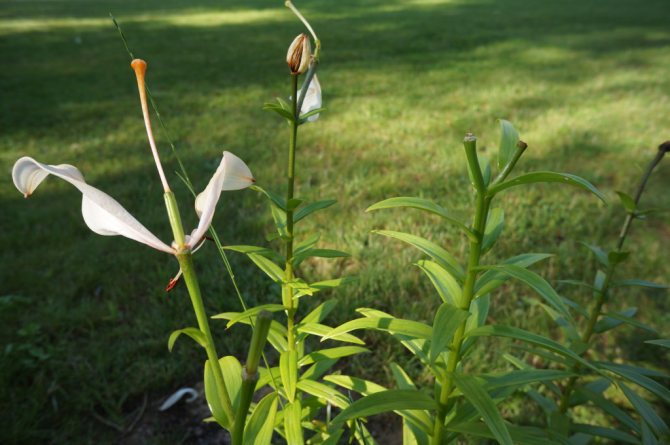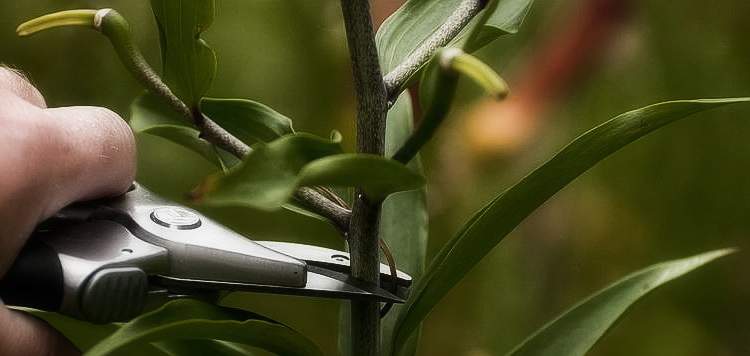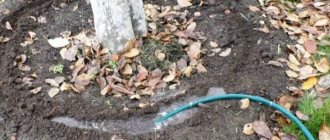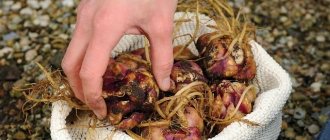Do you think that a lily is a flower that grows by itself and even if you do not take care of it, its gorgeous bloom will delight you every year? You are deeply mistaken, this is far from the case. So why do some growers proudly display their gorgeous beauties on forums, while others have flowers that look sickly and drooping? It turns out that it is a matter of improper care before, during, and after flowering.
All lilies need care and attention, especially the latest breeding innovations that do not tolerate cold winter weather. The army of fans of these flowers is growing every year, they are often interested in questions: how to properly care for flowers, whether or not to cut lilies after flowering, and in what conditions are the bulbs best stored.
Since the bulbs are stored without a stem, the stems must be removed. When to do this, when the lily has faded, or when the stems have withered, and the flower is getting ready for winter? Beginners, and not only, often have questions related to pruning lilies, so we will try to figure it out.
Pruning lilies after flowering
In order for plants growing in one place to delight you with their unique flowers and wonderful aroma, you should take proper care of them. This is not only loosening, watering, feeding, but also the timely pruning of leaves, because the entire development of the plant for the next year depends on the correct implementation of this procedure.
Very often, novice gardeners have a dilemma when to cut the leaves of a crop: immediately after flowering or much later. Our article will answer this and other questions.
Features of the
When the plants fade, only wilted stalks and leaves remain above the soil surface. Therefore, naturally there is a desire to put the flower bed in order by removing the protruding stems. However, this should not be done immediately after flowering.
The thing is that the bulb is stored with nutrients throughout the season, and photosynthesis takes place in the stems and leaves, as a result of which the accumulation of useful elements occurs. Therefore, by prematurely cutting off the stems and leaves, we form a weak bulb with our own hands, unable to produce a healthy plant next year.
rules
We learned that you don't need to prune your crops immediately after flowering and remove the leaves and stems from the plant to keep the bulbs healthy.
What to do with faded buds, the following rules will tell you (picture 1):
- After flying around the petals, only the seed pods need to be cut.
- Leaves and stems are not pruned after flowering. They die off naturally at the beginning of autumn, after which they are removed.
- In the case of cutting flowers for a bouquet, you should choose bushes with more than 5 buds. In this case, the bulb is likely to be of sufficient size. However, it is necessary to cut the flowers so that part of the stem remains above the surface of the soil.

Figure 1. Open field pruning technology
The aerial parts remaining after flowering (cutting) contribute to the restoration of the bulb.
More information about outdoor crop care and pruning is shown in the video.
Trimming time
Timing of pruning is one of the most common mistakes.It is important to know that the preliminary removal of the aboveground parts of the plant directly affects the development of the mother bulb, because as a result of the interruption of the processes of photosynthesis in the green organs of the plant, the process of formation and transport of nutrients to the roots is disrupted (Figure 2).
Note: Such a culture will not be able to grow a full-fledged bulb that can survive the winter and give abundant flowering the next year.
Therefore, it is worth being patient and waiting for the stems to die off naturally. This usually happens in the fall. As a result, the stems are pruned either late in the fall or in the spring.
Wintering and storage of lilies
Winter-hardy varieties of lilies survive the cold outdoors very well. For better safety, plantings are mulched with humus, straw, peat or other plant residues and covered with agromaterial.
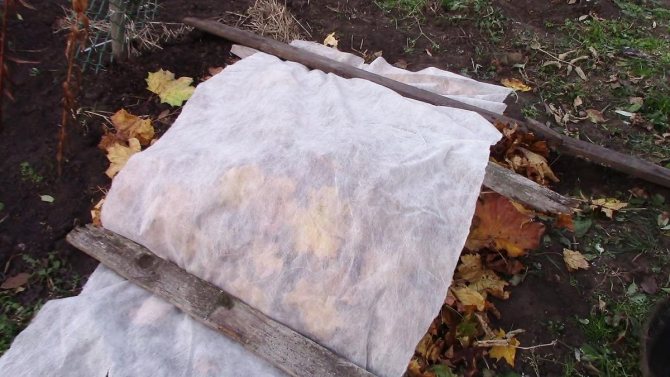

Lilies are covered with a layer of dry leaves and covered with agrofibre
But some capricious hybrids require annual digging and storage in a relatively warm place with an air temperature of about + 2 ... + 3 ° С.
You can store lilies:
- in a cellar or basement;
- in the refrigerator (on the bottom shelf or in the vegetable compartment).
Well-dried bulbs are placed in shallow wooden or plastic boxes, then sprinkled with a mixture of coarse sand, sawdust and peat. It is allowed to store lilies in boxes, shifting them with layers of sphagnum moss or burlap.
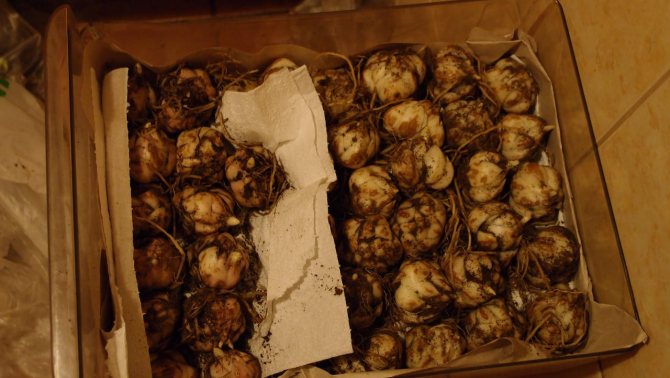

To store lilies in the cellar, the bulbs are laid out in shallow boxes or boxes.
Before laying for winter storage, lily bulbs are treated with insecticides (Fufanon, Karbofos, etc.).
To be kept in the refrigerator, the onions are placed in polyethylene bags with moistened peat or wrapped in a damp natural cloth.
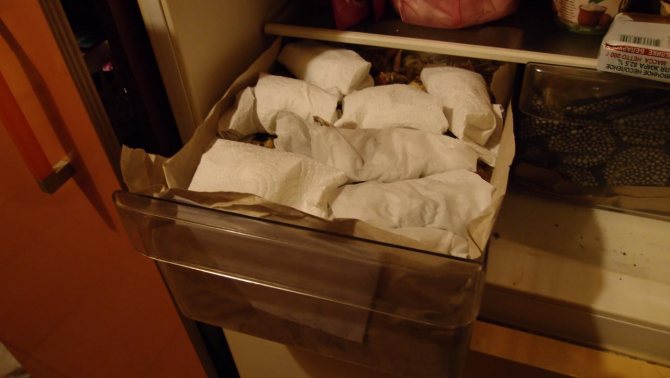

Lilies can be stored in the refrigerator by wrapping them in a damp linen cloth
It is necessary to constantly monitor the humidity so that the lilies do not dry out and, if necessary, lightly sprinkle the substrate.
Even frost-resistant lilies do not always survive the winter safely, sometimes they still freeze out. In order to guarantee not to lose the plants, I usually leave half of the bulbs to winter in the ground, and store the rest in boxes with wet sand in the cellar.
Video: recommendations for storing lilies
Do I need to prune lilies after flowering
The answer to the question whether it is necessary to prune the bushes after flowering is categorically negative. While the stem is alive, photosynthesis takes place in it with the formation of substances that feed the bulb. Thus, she prepares for wintering and flowering in the next season.


Figure 2. Optimal time to prune plants
But to remove unripe fruits, on the contrary, is desirable, because the plant spends such necessary forces on them, and the bulb receives a smaller amount of the necessary substances.
Protecting lilies in the open field from frost
Lilies planted overwintering in the open field need to create a shelter that will protect from frost. A layer of snow more than 10 cm thick saves from the cold weather. It is not worth hoping that the snow will fall before frost. It is better to help the flower overwinter and prevent freezing by sprinkling needles or foliage, peat in the place of its growth.
Note! If the winter has little snow, the ground of the flower garden can be additionally sprinkled with snow taken from other parts of the garden.
An important condition for the effectiveness of a shelter is to create it in time and remove it in time. If it is too early to remove the spruce legs scattered around the flower garden, to collect peat and foliage from the ground, then only the sprouts of the plant that have hatched can be damaged by frost. If the material protecting from frost is not removed for a long time, the plant will receive insufficient sunlight, the sprouts will hatch weak and thin. A flower bush will grow weak too.
Shelter lilies for the winter
How to prune a house lily after flowering
Varieties that are grown in flower pots go through the same developmental stages as open field plants: they fade, gradually dry out, and go into a dormant state. And in order to bloom next year, the bulb must make a certain supply of nutrients and rest.
Note: Therefore, if your pet has faded, in no case cut off its stems.
Simply reduce the flow of moisture while increasing the interval between waterings and stop spraying (Figure 3). In this way, you will activate the transfer of nutrients from the organs of the aerial part to the bulb and contribute to laying the foundation for growth and development in the new year.
Mistakes of novice florists
Novice growers often make the following mistakes:
- Prune the lilies too early, not waiting for the bulbs to ripen and the stems to dry out. By doing this, they leave almost no chance for the flowers to have a successful winter. And if they survive, they will be very weak next year.
- They are first pruned and then fed. If plants do not have green mass, then they cannot photosynthesize, and therefore feeding for them is rather harmful than useful. Therefore, lilies are first fed after they have bloomed, and only then, when the bulbs get stronger, the stems are cut off.
- Faded inflorescences are not cut off. If inflorescences are left on the lilies, then they will spend all their strength on the formation and ripening of fruits. This process can drag on until the cold weather, and with their onset, the bulbs will end up with a favorable time to prepare for winter.
- To make bouquets, they cut all flowers at once. Cutting off all flowers at once is tantamount to premature pruning of a bush. A plant without stems that is not prepared for winter loses its chances of successfully overwintering. But there is a way out - cut only 1-2 shoots from each lily, which has at least 4-5 strong stems. Then the rest will compensate for the cut.
When to prune lilies for the winter
The answer to this question is unambiguous: pruning of plants is carried out in late autumn after the natural death of stems and leaves. In this case, the stems are not completely removed, but low (15 cm) bushes are left above the soil surface.


Figure 3. Features of pruning indoor varieties
Some gardeners generally advise removing yellowed and dried stems in the spring.
Features of the
In order for the plants to remain in their normal condition until next year, you need to take care of preserving the bulb in the winter, especially if you do not plan to dig it up. This is where the question arises when to prune for the winter.
Tips and tricks from experienced florists
Lilies are a fairly common garden flower. And many summer residents have their own secrets of pruning this plant. Some of them are listed below:
- In order for the appearance of withering stems not to spoil the overall picture of the garden plot, it is necessary to plant annual plants with lilies, the flowering period of which coincides with the period of drying of the foliage. Planting ornamental tall grass is also a good solution.
- In order not to darken the view of the flower bed, it is advised to do a gradual pruning, i.e. prune the stem weekly as it dries.
- Some growers consider it unnecessary to prune the lily stem in autumn and leave it until spring.
Lilies are quite unpretentious garden plants to care for. Now, knowing when to cut lilies, it will not be difficult to grow a healthy bulb that will bloom with amazing, luxurious flowers every year.
What to cut off a lily so that it doesn't smell
Pruning is practiced not only after flowering, but also during it. These flowers are well known for their pungent and strong aroma, which is produced by the release of special volatile oils from all organs of the plant.However, this smell is not always pleasant for humans, and in some cases it can cause allergic reactions.
What to do if the bouquet is beautiful and the smell is too heavy for you? In this case, it is recommended to remove the stamens of flowers, because it is on them that the smelling pollen is collected. To do this, you need to bring a paper bag to the bud and carefully cut the stamens into it. When doing this, use gloves to prevent pollen from getting on your fingers. This procedure should be repeated with each blooming flower.
The author of the video will tell you how to get rid of the smell of these flowers.
https://youtu.be/exnTDRYEdVI
General rules for caring for lilies
Lilies belong to the Liliaceae family. These are bulbous plants. And in many respects the appearance of this flower depends on the quality of the bulb.
It will not be difficult to grow a beautiful, lush lily. She prefers morning sunlight, fertile, slightly moist soil with a large humus layer. Therefore, for her, you should choose a place where the sun hits in the morning. With a lack of light, these flowers will stretch into growth, that is, the development of the stem, and not the buds, will take place.
Lilies do not like acidic soil. Depending on the variety, they require a neutral or slightly acidic environment. Throughout their development, these flowers, like other garden plants, require feeding. Lilies respond well to mineral fertilizers. At the first stage of development, fertilizers are needed, which include nitrogen. And starting from the budding period, potash and phosphorus fertilizers should be applied to the soil.
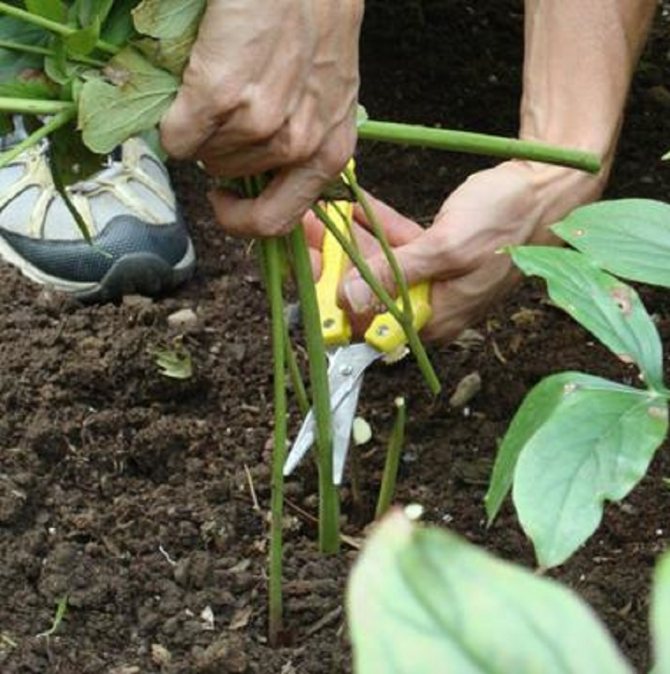

When to prune lilies
Important! Fresh manure must not be added to the soil. Organics are not suitable for feeding lilies.
How to properly dig up and store bulbs
Their safety for planting during the winter depends on the timely and correct digging of lily bulbs. It is important to take into account not only the plant species, but also the peculiarities of the climate in the growing region. For central Russia, there are certain dates for digging lilies:
- 1Adapted hybrid and oriental varieties are characterized by late flowering time. They are dug out in early September.
- 2LA hybrids and many species of Asiatic lilies are dug up at the end of August.
- 3Starting in mid-August, dig up OA hybrids and OT hybrids.
You can determine the most suitable time for digging a lily on your own. To do this, you need to look at the appearance of the lily. If it is all yellow and wilted, then you can dig it out. For transplanting, it is better to dig it out before the beginning of September.
Proper digging of lily bulbs for storage should be done in the following order:
- 1Using a garden pitchfork, you need to carefully dig up a clod of earth with lily bulbs.
- 2 Excess soil must be carefully removed. Then check for any child bulbs on the main bulb.
- 3 Cut the aboveground part of the plant at a height of 5 cm from the roots.
- 4 Rinse the bulbs and remove excess roots.
- 5 Soak the washed onions in a weak solution of potassium permanganate for one hour.
- 6 Sort the planting material by size, and put in a cool, dry place to dry.
Lily bulbs prepared for planting are best stored in plastic containers. Pour wood shavings at the bottom.
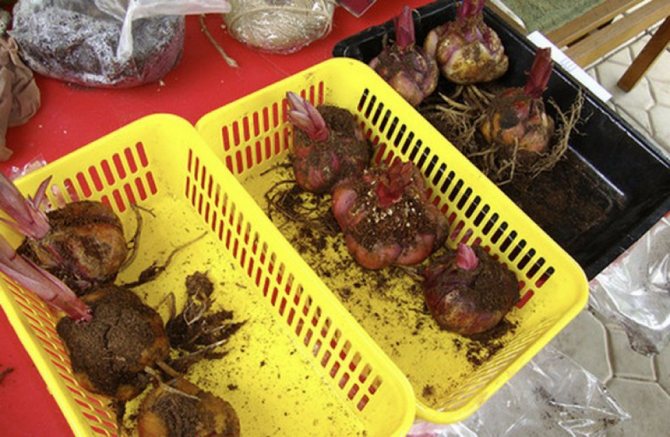

There should be ventilation holes in the lid of the container. In such conditions of storage of planting material, it will be well preserved until the new season.
Propagation by cuttings
Another easy way to propagate lilies after flowering is by cuttings. You can use a leaf with a stem piece or just a leaf, part of a stem with a dormant bud. To obtain cuttings, the stem is divided into parts with 5-7 leaves, the lower ones are removed, leaving 2-3 upper ones on the cutting. A leaf for grafting is taken at the top of the stem.
The prepared parts of the plant are treated with a solution of a growth stimulator, keeping in it for up to 12 hours. Then they are planted in prepared containers filled with a fertile substrate.
Note! All summer is suitable for propagation by cuttings, especially July, when the plant is in the budding or flowering period. The cuttings obtained at this time have a greater vigor of growth, are distinguished by better survival rates.
Leaves and cuttings to the middle of their length are deepened, slightly tilted, into the fertile black earth and covered with cellophane or covered with a glass jar. Water regularly, ventilate every day, lifting a film or jar. Remove the moisture droplets from the covering material before returning it to its place.
After 1-2 months, the parts of the plant buried in the ground take root, and young leaves begin to grow from the formed bulbs. The cuttings that have gone into growth are planted in separate containers and grown until spring. In the spring, seedlings are planted in open ground.
Lilies obtained by stem cuttings can bloom already in the first or second year of planting.
How to fertilize?
After flowering, lilies are weakened, and caring for them requires the creation of favorable conditions for the restoration of strength and the accumulation of nutrients - this is necessary for successful wintering. The soil near the plants must be fertilized with compounds with a high content of phosphorus and potassium, they are most suitable for the autumn season.
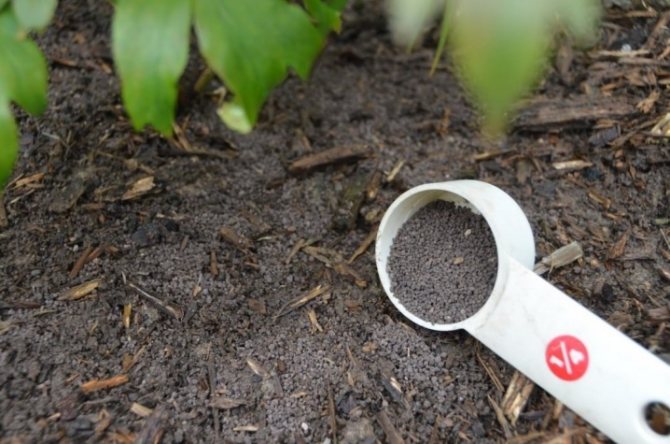

Consider the optimal feeding after flowering.
- "Superphosphate" - a tool that helps flowers to economically use moisture, prevents the appearance of fungal diseases, and is also necessary for the plant to survive freezing temperatures in winter. For 1 sq. m requires 25 g of the drug.
- "Potassium sulfate" - a composition with an increased level of potassium increases the immunity of flowers, thanks to which the nutrients delivered by the roots are absorbed faster by the bulbs. You only need 10-15 g of a substance for feeding the land on a plot of 1 sq. m.
- The same effect has "Potassium monophosphate", which, due to its neutral acidity, can be used in combination with other fertilizers. With the help of diluted powder (25 g + 10 l of water per 1 sq. M), it is possible to carry out foliar feeding.
- Also, lilies after flowering need organic fertilizers. - humus or compost, but only in rotten form (a bucket of fertilizer is taken for 1 sq. M.). Fresh organic matter is not used so as not to cause burns and death of the plant.
- Moreover, for lilies, the introduction of special means is favorableintended only for bulbous crops.
Plants must be constantly looked after until October, and although after flowering watering should not be abundant, the ground under the plant continues to be irrigated, and very carefully so that water does not get on the leaves and stem. Fertilization is usually combined with watering, weeding and loosening. Since the adventitious roots of the culture are located high, only the top layer of the soil can be loosened, moreover, very carefully.
Protection from pests and rodents
Rodents are a dangerous enemy of planting material for lilies in winter. If you do not organize protection, then they can destroy the bulbs in the garden. Poison baits are a simple defense. They need to be spread out in the beds before winter. There are also ultrasonic rodent-repelling devices. They effectively protect plants, but are expensive. Therefore, their use is limited.
To protect against rodents, you can use plastic containers in which the bulbs are placed. But for this, the planting material must be dug up and divided. You can buy these containers at hardware or garden stores.
Another way to control rodents is to tread the paths when there is a lot of snow.
The firefighter beetle causes great harm to lilies. It is called the lily beetle.He easily pretends to be dead when he senses danger, turning upside down. The lily beetle feeds on the stems and leaves of lilies. The firefighter beetle and its larvae are highly resistant to chemical insecticides. Therefore, it is often harvested by hand from the leaves.
In addition, the following pests can be found on lilies:
- 1 Lily fly.
- 2Tlu.
- 3 Spiderweb mite.
- 4Thrips.
To destroy them, you need to use various chemicals. Good results are obtained by Aktellik, Komandor and Aktara. They contain instructions for use.
Transfer
Varieties (for example, Asian and LA-hybrids), which quickly become overgrown with "babies", should be replanted annually. If they are not transplanted, the processes will take a lot of useful substances, moisture, the flowers will become small, the plants will start to hurt. The main part of the varieties must be looked after by moving them to a new ridge every 3 years. Return the bulbs to their original place no later than after 5 years. Plant the dug specimens immediately or put them in a bag of wet moss for a while in the refrigerator. You need to take care of lilies at the end of summer by transplanting them like this:
- Cut off the stems.
- Remove the heads from the ground: do this with forks.
- If the bulbs do not fall apart, gently separate them with your hands. Disconnect the kids.
- Peel the separated onions from the scales, rinse with water.
- Disinfect the material: soak it for 20 minutes in a solution of potassium permanganate or Karbofos.
- Dry the material, trim the roots a little, plant the bulbs.
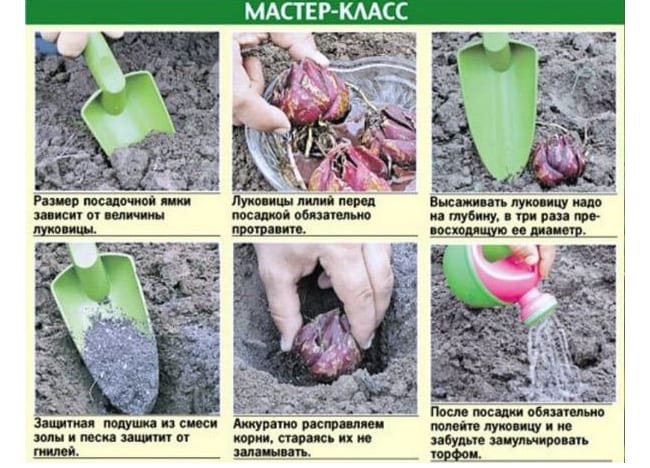

Planting lilies

